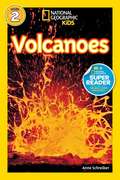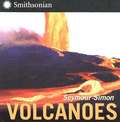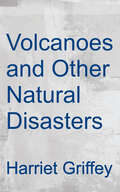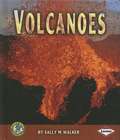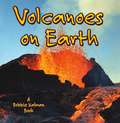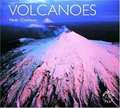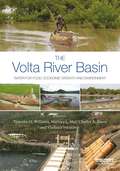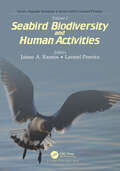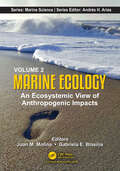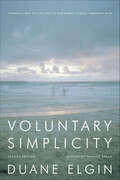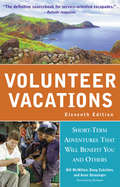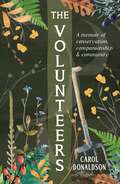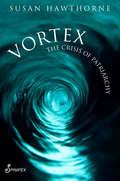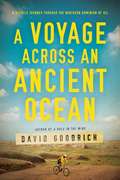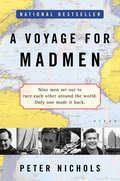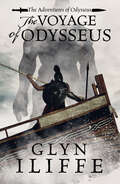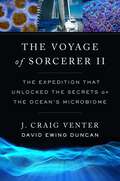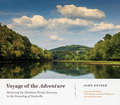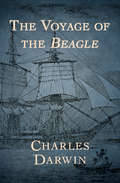- Table View
- List View
Volcanoes!
by Anne SchreiberThe cool story of volcanoes will intrigue kids and adults alike. Hot melted rock from the middle of our planet forces its way up through cracks in the Earth’s crusts, exploding violently and sometimes unexpectedly in volcanic fury that can terrorize populations for months, even years. Anne Schreiber’s narrative gives readers a little of the science, a little of the history, and a lot of the action.
Volcanoes
by Seymour Simon<P>Exceptional nonfiction for children from two of the most trusted names in science education: Seymour Simon and the Smithsonian Institution. <P>[This text is listed as an example that meets Common Core Standards in English language arts in grades 4-5 at http://www.corestandards.org.]
Volcanoes and Earthquakes
by Mary EltingDiscusses how earthquakes and volcanic eruptions occur and how they can be predicted.
Volcanoes and Earthquakes (Professor Hoot's Science Comics #4)
by Jen GreenEvery day brings a new adventure for Professor Hoot - and a new learning experience. There's a plume of smoke in the distance, it looks like a volcano has erupted! Professor Hoot sets off to investigate all about volcanoes and how they are formed, all while avoiding smoky feathers! Discover other natural distasters, such as earthquakes, tsunamis and landslides - and what to do in such events.An entertaining comic strip approach to KS1 science topics, Professor Hoot's Science Comics are accessible and full of fun. Each book is an adventure and a chance for readers to learn something new, before testing their knowledge at the end of each book in Professor Hoot's quiz. Collect each adventure: Big Machines; Dangerous Animals; Dinosaurs; Robots and AI; Space; Volcanoes and Earthquakes.
Volcanoes And Earthquakes (INsiders)
by Ken RubinINsiders brings volcanoes & earthquakes to life, with the most up-to-date information stimulating minds and imaginations in a whole new way.
Volcanoes and Other Natural Disasters (Dk Readers Series Dorling Kindersley Readers)
by Harriet Griffey Dorling Kindersley Publishing StaffDescribes natural disasters which have occurred in various places throughout the world including the eruption of Vesuvius in 79 A.D., the Yellow River flood in 1887, and the Australian bush fires in 1983.
Volcanoes (Early Bird Earth Science)
by Sally M. WalkerThis book introduces young readers to volcanoes--what they are, how they form, and how they affect people.
Volcanoes on Earth
by Bobbie KalmanDramatic photographs of spewing and flowing lava will capture the attention of any child. in this fantastic new book, children will be excited to learn what a volcano is and what makes it erupt. Simple explanations describe the different kinds of volcanoes, including cinder, cone-shaped, shield, and composite as well as the different kinds of lava and the land formations they create on land and under the ocean. Other topics include the reason volcanoes often erupt during earthquakes, why giant tsunami waves are sometimes created by underwater earthquakes, and how volcanoes are studied in order to predict and prepare for eruptions. Children will also enjoy making their own volcano out of household materials.
Volcanoes (Worldlife Library)
by Peter ClarksonWhat are volcanoes? Where and why do they happen? The aim of this book is to answer these questions and to explain one of the great natural wonders of the Earth. Volcano! Just the mention of the word creates a mental picture, which varies with the listener's own perception. An artist may think of the classical shape of Mount Fuji; a historian may recall the destruction of Pompeii by Vesuvius; a geologist may speculate about the gas content of the lava in relation to its viscosity; a newspaper editor may see the scope for spectacular photographs and stories of human suffering and heroism that will boost newspaper circulation. Whatever thoughts spring to mind, nobody can be but impressed by the awful power of a volcanic eruption and the devastation that may be caused.
The Volta River Basin: Water for Food, Economic Growth and Environment (Earthscan Series on Major River Basins of the World)
by Timothy O. Williams Marloes Mul Charles A. Biney Vladimir SmakhtinThe Volta River Basin (VRB) is an important transboundary basin in West Africa that covers approximately 410,000 square kilometres across six countries: Benin, Burkina Faso, Côte d’Ivoire, Ghana, Mali and Togo. Its natural resources sustain the livelihoods of its population and contribute to economic development. This book provides a comprehensive, interdisciplinary review and assessment of the issues and challenges faced. The authors provide a science-based assessment of current and future scenarios of water availability, the demands of key sectors, including agriculture and hydropower, and the environment under changing demographic, economic, social and climatic conditions. They also identify solutions and strategies that will allow available water resources to be sustainably used to improve agricultural productivity, food security and economic growth in the VRB. Overall, the work examines from a multidisciplinary and multi-stakeholder perspective the solutions and strategies to improve the use of water and other natural resources in the VRB to achieve enhanced food security, livelihoods and economic growth.
Volume 1: Seabird Biodiversity and Human Activities (Aquatic Sciences)
by Jaime A. RamosSeabirds are global travellers connecting oceans and seas all over the world, and facing multiple threats at local and global scales. Seabirds are long-lived top predators, reflecting changes at lower trophic levels, and are good models to assess ecological changes produced by human societies. Thus, world-wide collaborations are needed to understand seabird ecology and to develop effective conservation measures benefitting both humans and seabird populations.This book provides a modern overview on seabird biodiversity studies: it begins by covering the most up-to-date techniques to study seabirds, and then focus on pragmatic issues related with interactions between seabirds and humans, the use of seabirds as ecological indicators and conservation of seabirds. It gives an updated insight on all these topics and highlights gaps that need further development for a comprehensive understanding of the relationships between seabirds and human actions.This book covers the response of the seabird research community to a biodiversity crisis aiming to contribute towards environmental sustainability. It should provide inspiration to a wide range of professionals and students, including the much needed world-wide collaboration between research groups and practitioners. In this way seabird research and conservation provide an inspiration for the solution of global issues such as climate change.
Volume 2: An Ecosystemic View of Anthropogenic Impacts (Marine Science Series)
by Juan M. Molina Gabriela E. BlasinaMarine systems face a multitude of anthropogenic stressors such as climate change, recreational and commercial fishing, aquaculture practices, pollution, and coastal urbanization. These stressors exert escalating pressure on marine ecosystems, leading to noticeable changes in habitat conditions as well as alterations in the abundance and diversity of their communities. Understanding the impacts of these stressors proves challenging due to their interactions with various factors, such as species richness, environmental fluctuations, system openness, stressor tolerance, and the occurrence rate and intensity of each stressor. Therefore, a comprehensive analysis of the entire ecosystem is crucial. It is essential to consider the unique characteristics of each marine environment when assessing the cumulative stress that affects them. This book provides insights into the functioning of marine ecosystems and their responses to both natural and human-induced drivers within the framework of sustainable marine resource utilization. This book will make a valuable contribution to the scientific community, serving as a resource to inform decision-makers and the general public about the current state of knowledge regarding the marine environment and the human footprints on our seas.
Volume 5: Maritime Communities and Vegetation of Open Habitats
by J. S. RodwellBritish Plant Communities is the first systematic and comprehensive account of the vegetation types of this country. It covers all natural, semi-natural and major artificial habitats in Great Britain (but not Northern Ireland), representing the fruits of fifteen years of research by leading plant ecologists. The book breaks new ground in wedding the rigorous interest in the classification of plant communities that has characterized Continental phytosociology with the deep concern traditional in Great Britain to understand how vegetation works. The published volumes have been greeted with universal acclaim, and the series has become firmly established as a framework for a wide variety of teaching, research and management activities in ecology, conservation and land-use planning.
Voluntary Environmental Management: The Inevitable Future
by John MorelliA shift from government oversight to private sector self-regulation appears to be the future of environmental management. This will be a complex and complicated transition, as individual companies attempt to balance their needs against that of the surrounding communities - and world.Voluntary Environmental Management: The Inevitable Future explores how business and industry are preparing for this dramatic shift in responsibility and accountability.John Morelli pinpoints companies that have already adopted environmental auditing and management tools; examines the deficiencies of government-imposed environmental regulations; and shows how businesses can become more proactive in monitoring and managing their environmentally affective activities.The role of global marketplace forces receives substantial emphasis in Voluntary Environmental Management: The Inevitable Future, especially in light of the widespread international acceptance of new ISO 14000 standards.
The Voluntary Environmentalists
by Aseem Prakash Matthew PotoskiA novel theoretical framework to analyse the effectiveness of voluntary environmental programs, including ISO 14001.
Voluntary Simplicity Second: Toward a Way of Life That Is Outwardly Simple, Inwardly Rich
by Duane ElginWhen Voluntary Simplicity was first published in 1981, it quickly became recognized as a powerful and visionary work in the emerging dialogue over sustainable ways of living. Nearly three decades later, as the planet’s environmental stresses become more urgent than ever, Duane Elgin has revised and updated his revolutionary book.Voluntary Simplicity is not about living in poverty; it is about living with balance. This book illuminates the pattern of changes that an increasing number of people around the world are making in their everyday lives—adjustments in day-to-day living that are an active, positive response to the complex dilemmas of our time. By embracing a lifeway of voluntary simplicity—characterized by ecological awareness, frugal consumption, and personal growth—people can change their lives. And in the process, they have the power to change the world.
Volunteer Vacations: Short-Term Adventures That Will Benefit You and Others
by Bill Mcmillon Doug Cutchins Anne Geissinger Ed AsnerFor the increasing number of people looking for ways to make a difference while on vacation, this fully updated edition is filled with in-depth information to get them ready for their adventure, including contacts, locations, costs, dates, project details, and profiles of 150 select organizations running thousands of programs in the United States and around the world. Including new details about long-term projects and organizations specifically tailored for families, seniors, and the disabled, this definitive sourcebook provides a wealth of opportunities for anyone interested in taking a truly meaningful vacation and provides new anecdotes about all kinds of jobs and the positive impact they had on volunteers' lives.
The Volunteers: A Memoir of Conservation, Companionship and Community
by Carol DonaldsonWhen Carol's world suddenly unravels, she stumbles upon an unexpected opportunity: leading a ragtag team of countryside conservation volunteers. The Volunteers is a heartwarming tale that celebrates the redemptive force of the woods and wildlife, and illustrates how, even in the most unexpected places, we can find a community to call our own.
Vortex: The Crisis of Patriarchy
by Susan HawthorneDo we want to live in a world without birdsong? The pesticides, the coal mines, the clear-felling forestry industry, the industrial farmers are destroying the earth with their insistence on profit. But what point is profit on a dead and silent planet?In this enlightening yet devastating book, Susan Hawthorne writes with clarity and incisiveness on how patriarchy is wreaking destruction on the planet and on communities. The twin mantras of globalisation and growth expounded by the neoliberalism that has hijacked the planet are revealed in all their shabby deception. Backed by meticulous research, the author shows how so-called advances in technology are, like a Trojan horse, used to mask sinister political agendas that sacrifice the common good for the shallow profiteering of corporations and mega-rich individuals.The biotechnologists see the lure of cure, rising share prices and profits.She details how women, lesbians, people with disabilities, Indigenous peoples, the poor, refugees and the very earth itself are being damaged by the crisis of patriarchy that is sucking everyone into its vortex. Importantly, this precise and insightful volume also shows what is needed to get ourselves out of this spiral of destruction: a radical feminist approach with compassion and empathy at its core.Shame is an emotion of the powerless because they cannot change the rules.The book shows a way out of the vortex: it is now up to the collective imagination and action of people everywhere to take up the challenges Susan Hawthorne shows are needed. This is a vital book for a world in crisis and should be read by everyone who cares about our future.
A Voyage Across an Ancient Ocean: A Bicycle Journey Through the Northern Dominion of Oil
by David GoodrichIn the face of widespread misinformation and misunderstanding, a climate scientist ventures into the vast heart of America&’s new oil country on just two wheels.Recently recovered from his epic bicycle journey that took him from the Delaware shore to the Oregon coast, distinguished climate scientist David Goodrich sets out on his bike again to traverse the Western Interior Seaway—an ancient ocean that once spread across half of North America. When the waters cleared a geologic age ago, what was left behind was vast, flat prairie, otherworldly rock formations, and oil shale deposits. As Goodrich journeys through the Badlands and Theodore Roosevelt National Park and across the prairies of the upper Midwest and Canada, we get a raw and ground-level view of where the tar sands and oil reserves are being opened up at an incredible and unprecedented pace. Extraordinary and unregulated, this &“black goldrush&” is boom and bust in every sense. In a manner reminiscent of John McPhee and Rachel Carson, combined with Goodrich&’s wry self-deprecation and scientific expertise, A Voyage Across an Ancient Ocean is a galvanizing and adventure-filled read that gets to the heart of drilling on our continent.
A Voyage For Madmen: Nine Men Set Out To Race Each Other Around The World. Only One Made It Back ...
by Peter NicholsIn 1968, nine sailors set off on the most daring race ever held: to single-handedly circumnavigate the globe nonstop. It was a feat that had never been accomplished and one that would forever change the face of sailing. Ten months later, only one of the nine men would cross the finish line and earn fame, wealth, and glory. For the others, the reward was madness, failure, and death. In this extraordinary book, Peter Nichols chronicles a contest of the individual against the sea, waged at a time before cell phones, satellite dishes, and electronic positioning systems. A Voyage for Madmen is a tale of sailors driven by their own dreams and demons, of horrific storms in the Southern Ocean, and of those riveting moments when a split-second decision means the difference between life and death.
The Voyage of Odysseus (The Adventures of Odysseus #Vol. 5)
by Glyn IliffeWith the Trojan War over, Odysseus heads home, and the real challenge now begins in this historical adventure by the author of The Oracles of Troy. The armies of Troy have been defeated, and the city lies in ruins. His oath fulfilled, Odysseus can at last sail for Ithaca and the long-awaited reunion with his family. But the gods, who were once his allies, have turned against him. Exiled with the warrior Eperitus, he is thrust into a world of seductive demi-gods and man-eating monsters. As they struggle from one supernatural encounter to another, never knowing what the next landfall will bring, their chances of ever returning home grow fainter. Tensions reach breaking point between Odysseus and his crew. Even the faithful Eperitus&’s loyalties are divided. Eventually only one hope remains. For Odysseus to see his wife and son again, he must tread the paths of the dead and descend into the pits of Hell itself . . . Praise for The Voyage of Odysseus:&“From one adventure to another the pace never lets up. Like Homer&’s original, Glyn Iliffe&’s series is destined to become a classic!&” —Steven McKay, author of the Warrior Druid of Britain series
The Voyage of Sorcerer II: The Expedition That Unlocked the Secrets of the Ocean’s Microbiome
by J. Craig Venter David Ewing Duncan“Will undoubtedly shape our understanding of the global ecosystem for decades to come.”—Siddhartha Mukherjee, author of The Emperor of All MaladiesA celebrated genome scientist sails around the world, collecting tens of millions of marine microbes and revolutionizing our understanding of the microbiome that sustains us.Upon completing his historic work on the Human Genome Project, J. Craig Venter declared that he would sequence the genetic code of all life on earth. Thus began a fifteen-year quest to collect DNA from the world’s oldest and most abundant form of life: microbes. Boarding the Sorcerer II, a 100-foot sailboat turned research vessel, Venter traveled over 65,000 miles around the globe to sample ocean water and the microscopic life within.In The Voyage of Sorcerer II, Venter and science writer David Ewing Duncan tell the remarkable story of these expeditions and of the momentous discoveries that ensued—of plant-like bacteria that get their energy from the sun, proteins that metabolize vast amounts of hydrogen, and microbes whose genes shield them from ultraviolet light. The result was a massive library of millions of unknown genes, thousands of unseen protein families, and new lineages of bacteria that revealed the unimaginable complexity of life on earth. Yet despite this exquisite diversity, Venter encountered sobering reminders of how human activity is disturbing the delicate microbial ecosystem that nurtures life on earth. In the face of unprecedented climate change, Venter and Duncan show how we can harness the microbial genome to develop alternative sources of energy, food, and medicine that might ultimately avert our destruction.A captivating story of exploration and discovery, The Voyage of Sorcerer II restores microbes to their rightful place as crucial partners in our evolutionary past and guides to our future.
Voyage of the Adventure: Retracing the Donelson Party's Journey to the Founding of Nashville
by John GuiderIn the harsh winter of 1779, as the leader of a flotilla of settlers, John Donelson loaded his family and thirty slaves into a forty-foot flatboat at the present site of Kingsport, Tennessee. Their journey into the wilderness led to the founding of a settlement now known as Nashville—over one thousand river miles away. In the fall of 2016, photographer John Guider retraced the Donelson party's journey in his hand-built fourteen-and-a-half-foot motorless rowing sailboat (named Adventure II after Donelson's boat) while making a visual documentation of the river as it currently exists 240 years later. This photo book contains more than 120 striking images from the course of the journey, allowing the reader to see how much has changed and how much has remained untouched in the two and a half centuries since Donelson first took to the water. Equally significant, the essays include long-ignored contemporary histories of both the Cherokee whom Donelson encountered and the slaves he brought with him, some of whom did not survive the journey. From his platform just a few feet above the waterline, Guider, a professional photographer, created images of the thousand-mile trip along three of Tennessee's most notable rivers.
The Voyage of the Beagle: Journal Of Researches Into The Natural History And Geology Of The Countries Visited During The Voyage Of H. M. S. Beagle Round The World
by Charles DarwinThe riveting firsthand account of the historic voyage that led to the theory of evolution When the HMS Beagle set sail in 1831, the science of biology was not far removed from the Dark Ages. When the ship returned to England nearly five years later, Charles Darwin had the makings of a theory that would revolutionize our understanding of the natural world. From volcanoes in the Galapagos to the coral reefs of Australia, The Voyage of the Beagle documents the young naturalist&’s encounters with some of the earth&’s most stunning features. Darwin&’s observations of the people, places, and events he experienced make for compelling reading and offer a fascinating window into the intellectual development of his ideas about natural selection. A brilliant travelogue and a revealing glimpse into the Victorian mindset, The Voyage of the Beagle is an indispensable companion volume to On the Origin of Species. This ebook has been professionally proofread to ensure accuracy and readability on all devices.
